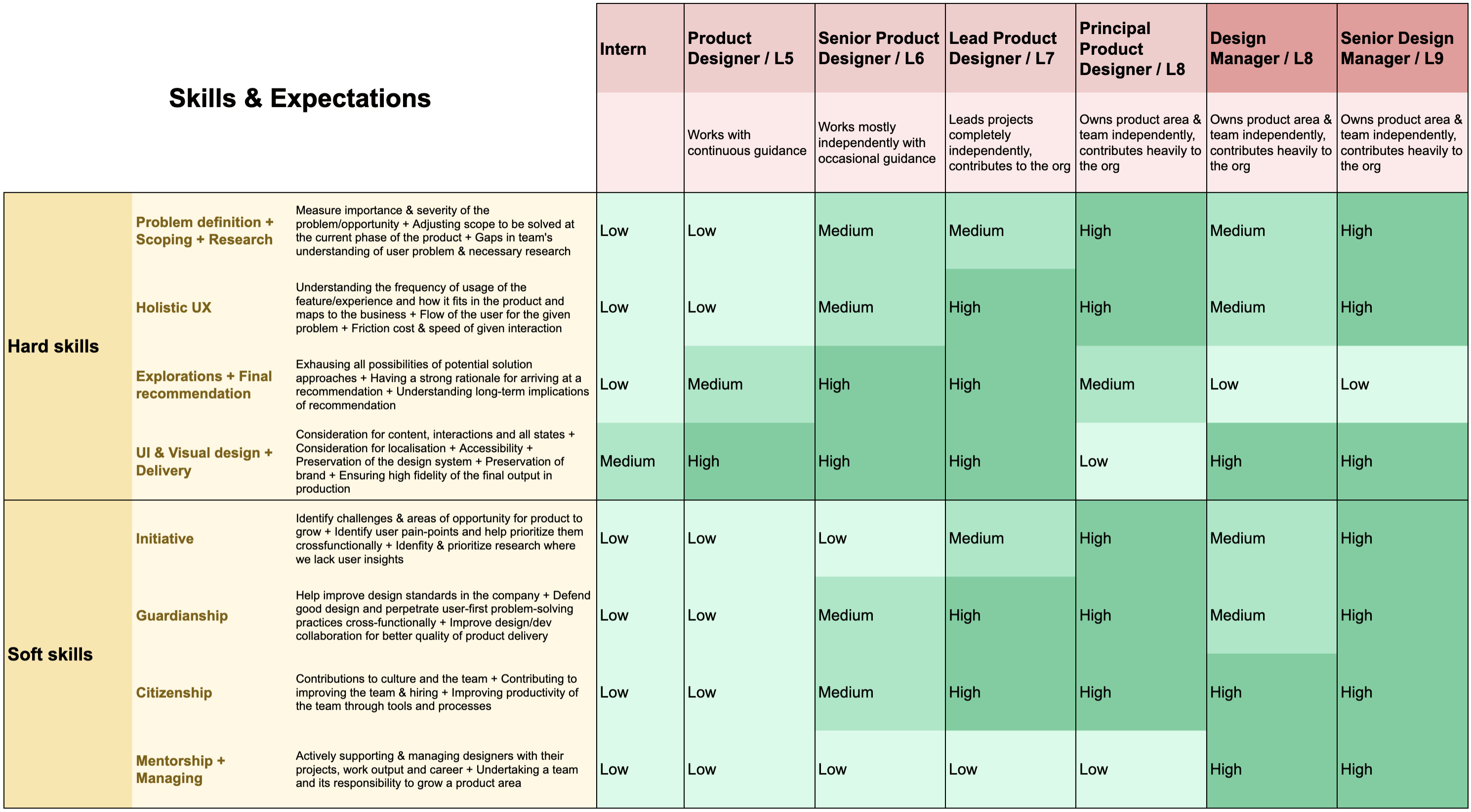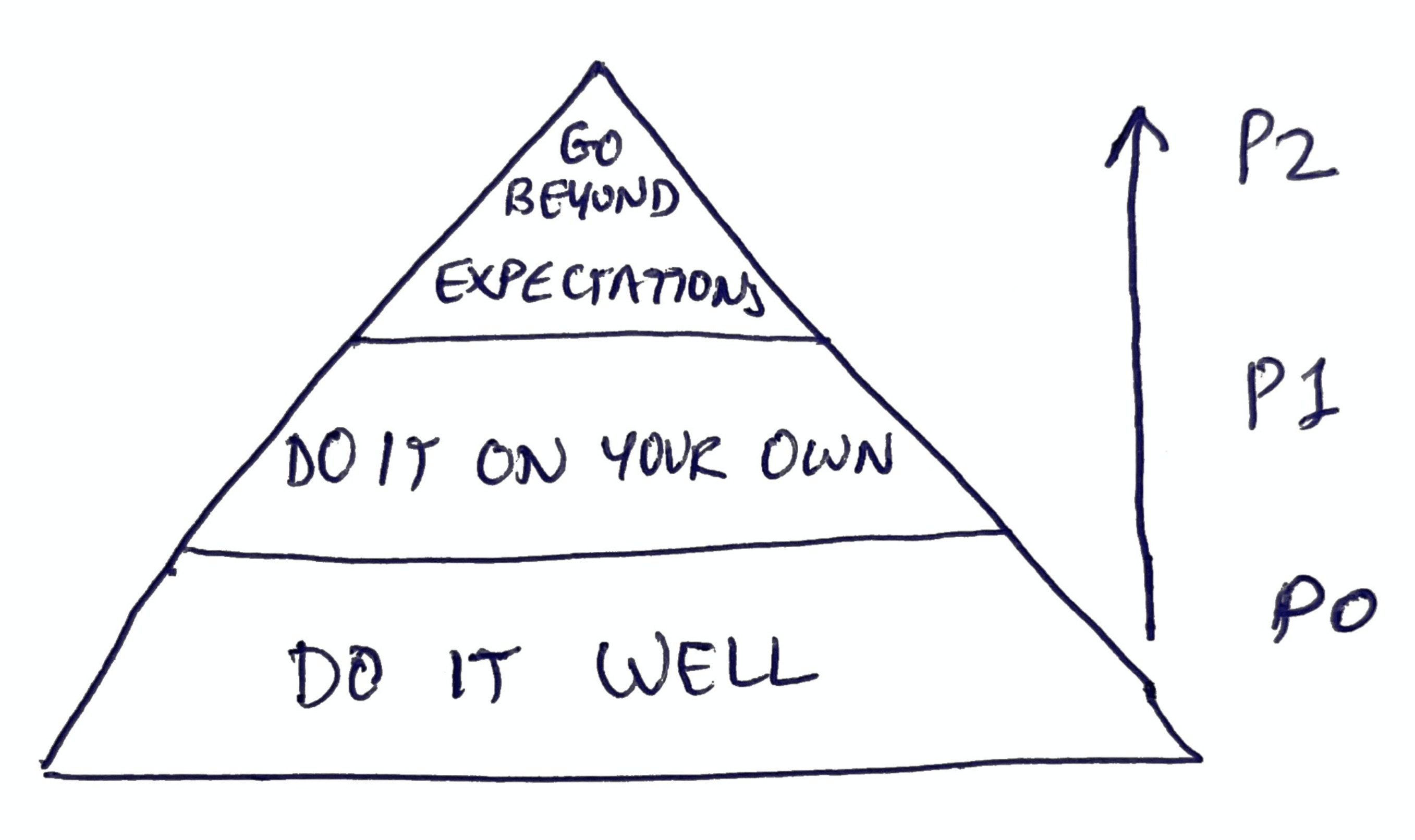Design Org at Unacademy
Building a good design org is a very interesting challenge. The differences in scale, product area and culture of startups mean that there are different ways to build a good design org. At Unacademy, we have developed a specific expectation from the designer’s role and have built an org around it. Let’s dive into the details of the current state of the org, how we map skills to the ladder and how we hire.
A fairly common question in the designer-sphere: How do I know I’m ready to level up or warrant a promotion? What are the L+1 expectations?
Setting up the ladder
Setting up a design ladder can go two ways depending on whether your org has existing calibration or not –
Case 1
Prior calibration doesn’t exist, and everyone’s titled a ‘Designer’: It’s useful in this scenario to start with a reference calibration ladder (we’ve open-sourced ours below). Once you have a ladder, you sit down with each one of your designers and understand their role, competencies and impact so far and start mapping them to a level on the ladder. This is a time consuming exercise but one that is very important to identify strengths and gaps in the skillsets of your team.
Case 2
Prior calibration exists but isn’t documented in detail (or at all): This is a tricky one. Your design team members are already calibrated on a level but it’s not precisely understood what the specific expectations from each level are. Here I’d recommend starting with a rough draft of the design ladder and treat it as a working copy. You’d still need to sit down with your designers and understand individual competencies in depth. But here the mapping exercise is a bit of a two-way street – your design ladder keeps getting updated as you recognize and bucket the skills in your designers to what their current level is. The reason why it’s a two-way street is because you can’t ‘update’ someone’s level just because you came up with a new calibration ladder.
We were Case 2 at Unacademy when I joined. My first operational change was to formalize the ladder calibration.
It was a 3 step process:
- Get each designer in the team to present their work in detail, like a mini portfolio presentation
- Make empirical calibration for each designer you talk to
- Formalize the level mapping for each designer and communicate the expectations clearly
So what sort of a design ladder did we come up with?
Calibration levels
Here it is. We broke it up in 2 skill areas: Hard skills and soft skills, to keep things simple.

Low: You exhibit the skill with continual guidance
Medium: You exhibit the skill with occasional guidance
High: You exhibit the skill with no guidance
Low / Medium / High indicate the expectation for that skill from that level. You could be going above the expectation on a particular skill. That is great and warrants a level up when done consistently, but you can’t be going below.
Features of the ladder
- As you level up, expectations shift from pure hard skills to [ hard skills + soft skills ] – as it should be
- You warrant a promotion when you demonstrate L+1 skills consistently (for at least ~1 evaluation cycle)
- The ladder ‘starts’ at High expectation for UI & Visual Design + Delivery (more on this in a bit)
Why this ladder
A calibration ladder of an org is an amalgamation of the talent the org has, and the talent the org needs.
Google’s design calibration ladder is stacked with 10+ levels. Google can hire, nurture, and support those many levels because of the bandwidth and operational infrastructure they have. Most startups do not have this luxury and hence they have to optimize for more immediate and near-term needs.
A company like Google can afford to hire a designer and allow them 4-5 months to ramp up and start performing. A startup would need the designer to be up and running within weeks.
A startup’s competency gradient is narrower and more suited to urgent and near-term needs, compared to a large company (like Google). This is why we don’t invite design interns at the moment. We’ve had a lot of interest for internships and I’m deeply grateful for that. We’ll invite folks starting the summer of 2021.
One exception
Every once in a while you meet a candidate who’s a breath of fresh air. They don’t currently map perfectly to the lowest level you’re hiring for. But they’re self-aware, constantly learning and go the extra mile in showcasing the immense self-initiative they have. They’re not a static dot stuck at L-1. They’re a dot-and-a-line as I call them. We’d always hire these people because they’re extremely coachable. You tell them a half and they grasp the other half on their own. They figure stuff out. I’d not worry about them not yet fitting the ladder.
Self-awareness and growth mindset are rare qualities. We’d never pass on those.
So what does our hiring process focus on?
We look for 3 key things throughout our conversations with the candidate:
-
P0 Quality of output: Your UI & visual design output is non-negotiable (hence, this forms the basis of our design ladder, where all levels have this skill at High expectation)
-
P1 Independent project execution: You should be able to work very closely with PMs (mostly) on your own, question the product direction and improve the quality of our collective problem-solving thinking
-
P2 High agency behavior: You should contribute to covering for opportunity blind spots, find impactful efforts and drive them with functional leadership

Disclaimer: All frameworks are reductionist compression tools. If you apply them too strictly, you risk missing out on talent anomalies (hence the exception above).
An informed org is a relaxed org
Your culture is a filter. The more clearly you communicate it, the higher quality interest you generate from people outside, and the more transparency you inculcate inside.
As a leader, you owe it to your team to create a transparent and an informed org. When you set a better internal framework of role expectations and evaluation, your team can focus on solving user’s problems and not spend hours being paranoid about their own.
I’m deeply interested in org design, people dynamics, the second-order effects of internal processes and so on. Hit me up on me@hvpandya.com if you want to chat.